Analysis of Feminist Criminology: Theories, Perspectives, and Impact
VerifiedAdded on 2022/08/16
|7
|1434
|8
Essay
AI Summary
This essay provides an overview of feminist criminology, a school of thought that emerged in response to the historical disregard of women in traditional criminology studies. It begins by discussing the core tenets of feminist criminology, including the argument that sexual exploitation is a primary driver of gender inequality and that social structures support male dominance. The essay then delves into various feminist theories, such as liberal feminism, radical feminism, Marxist feminism, social feminism, cultural feminism, standpoint feminism, and critical race theory, highlighting their distinct perspectives on female criminality and societal inequalities. The author concludes that liberal feminism offers the best approach for legal reform to prevent exploitation. The essay emphasizes the significant contribution of feminist criminology in promoting equality between genders and prompting a re-evaluation of the status of women in the context of crime.
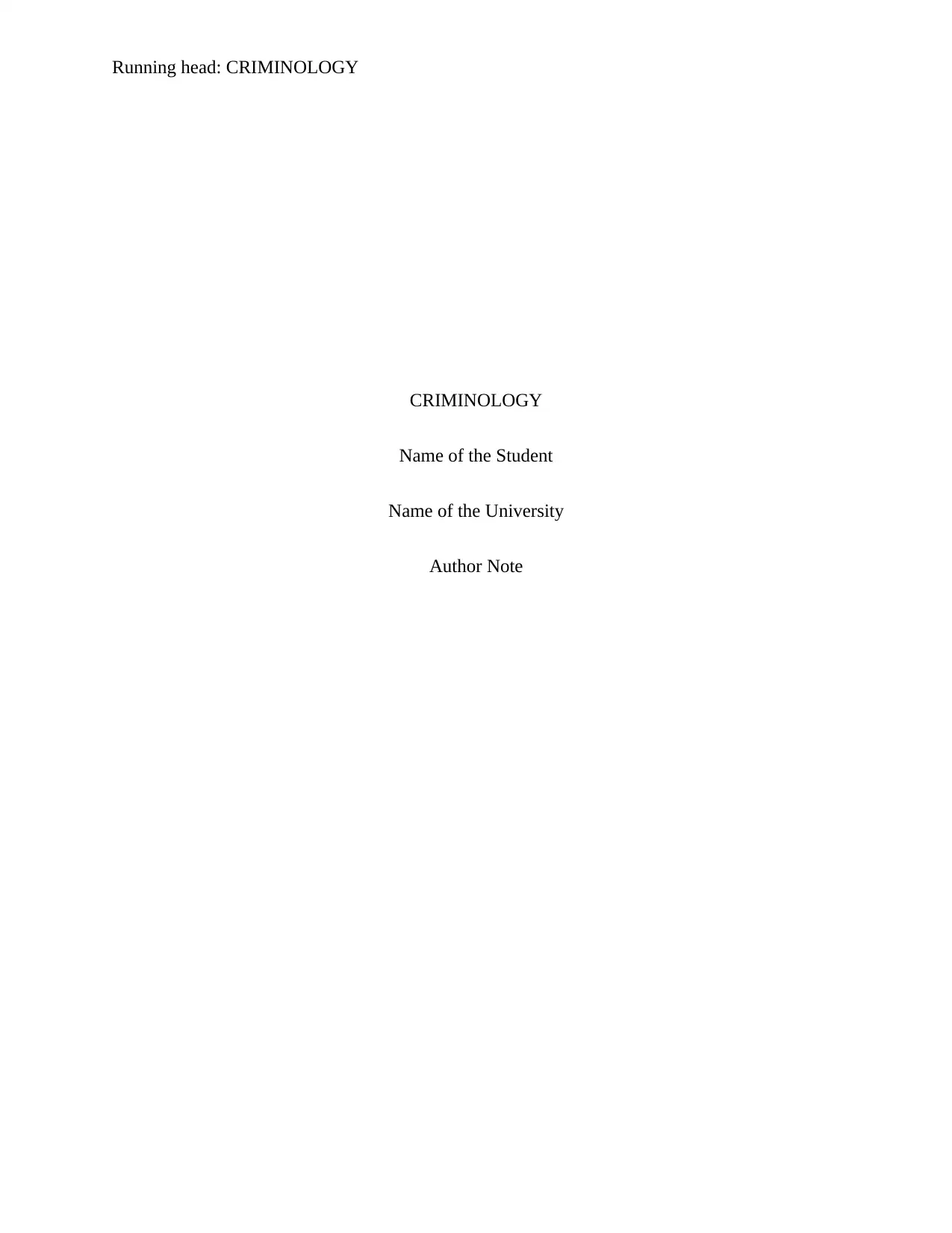
Running head: CRIMINOLOGY
CRIMINOLOGY
Name of the Student
Name of the University
Author Note
CRIMINOLOGY
Name of the Student
Name of the University
Author Note
Paraphrase This Document
Need a fresh take? Get an instant paraphrase of this document with our AI Paraphraser
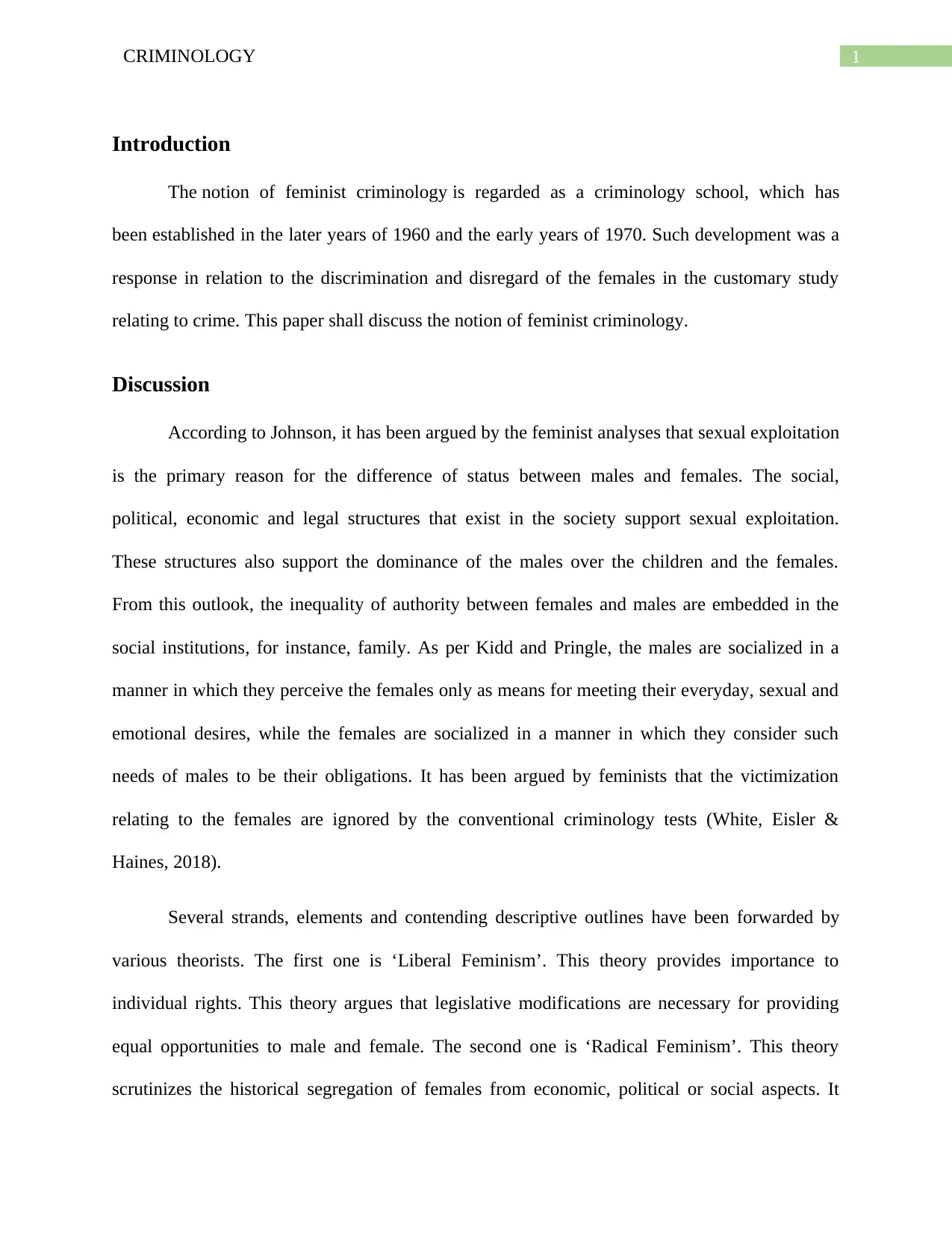
1CRIMINOLOGY
Introduction
The notion of feminist criminology is regarded as a criminology school, which has
been established in the later years of 1960 and the early years of 1970. Such development was a
response in relation to the discrimination and disregard of the females in the customary study
relating to crime. This paper shall discuss the notion of feminist criminology.
Discussion
According to Johnson, it has been argued by the feminist analyses that sexual exploitation
is the primary reason for the difference of status between males and females. The social,
political, economic and legal structures that exist in the society support sexual exploitation.
These structures also support the dominance of the males over the children and the females.
From this outlook, the inequality of authority between females and males are embedded in the
social institutions, for instance, family. As per Kidd and Pringle, the males are socialized in a
manner in which they perceive the females only as means for meeting their everyday, sexual and
emotional desires, while the females are socialized in a manner in which they consider such
needs of males to be their obligations. It has been argued by feminists that the victimization
relating to the females are ignored by the conventional criminology tests (White, Eisler &
Haines, 2018).
Several strands, elements and contending descriptive outlines have been forwarded by
various theorists. The first one is ‘Liberal Feminism’. This theory provides importance to
individual rights. This theory argues that legislative modifications are necessary for providing
equal opportunities to male and female. The second one is ‘Radical Feminism’. This theory
scrutinizes the historical segregation of females from economic, political or social aspects. It
Introduction
The notion of feminist criminology is regarded as a criminology school, which has
been established in the later years of 1960 and the early years of 1970. Such development was a
response in relation to the discrimination and disregard of the females in the customary study
relating to crime. This paper shall discuss the notion of feminist criminology.
Discussion
According to Johnson, it has been argued by the feminist analyses that sexual exploitation
is the primary reason for the difference of status between males and females. The social,
political, economic and legal structures that exist in the society support sexual exploitation.
These structures also support the dominance of the males over the children and the females.
From this outlook, the inequality of authority between females and males are embedded in the
social institutions, for instance, family. As per Kidd and Pringle, the males are socialized in a
manner in which they perceive the females only as means for meeting their everyday, sexual and
emotional desires, while the females are socialized in a manner in which they consider such
needs of males to be their obligations. It has been argued by feminists that the victimization
relating to the females are ignored by the conventional criminology tests (White, Eisler &
Haines, 2018).
Several strands, elements and contending descriptive outlines have been forwarded by
various theorists. The first one is ‘Liberal Feminism’. This theory provides importance to
individual rights. This theory argues that legislative modifications are necessary for providing
equal opportunities to male and female. The second one is ‘Radical Feminism’. This theory
scrutinizes the historical segregation of females from economic, political or social aspects. It
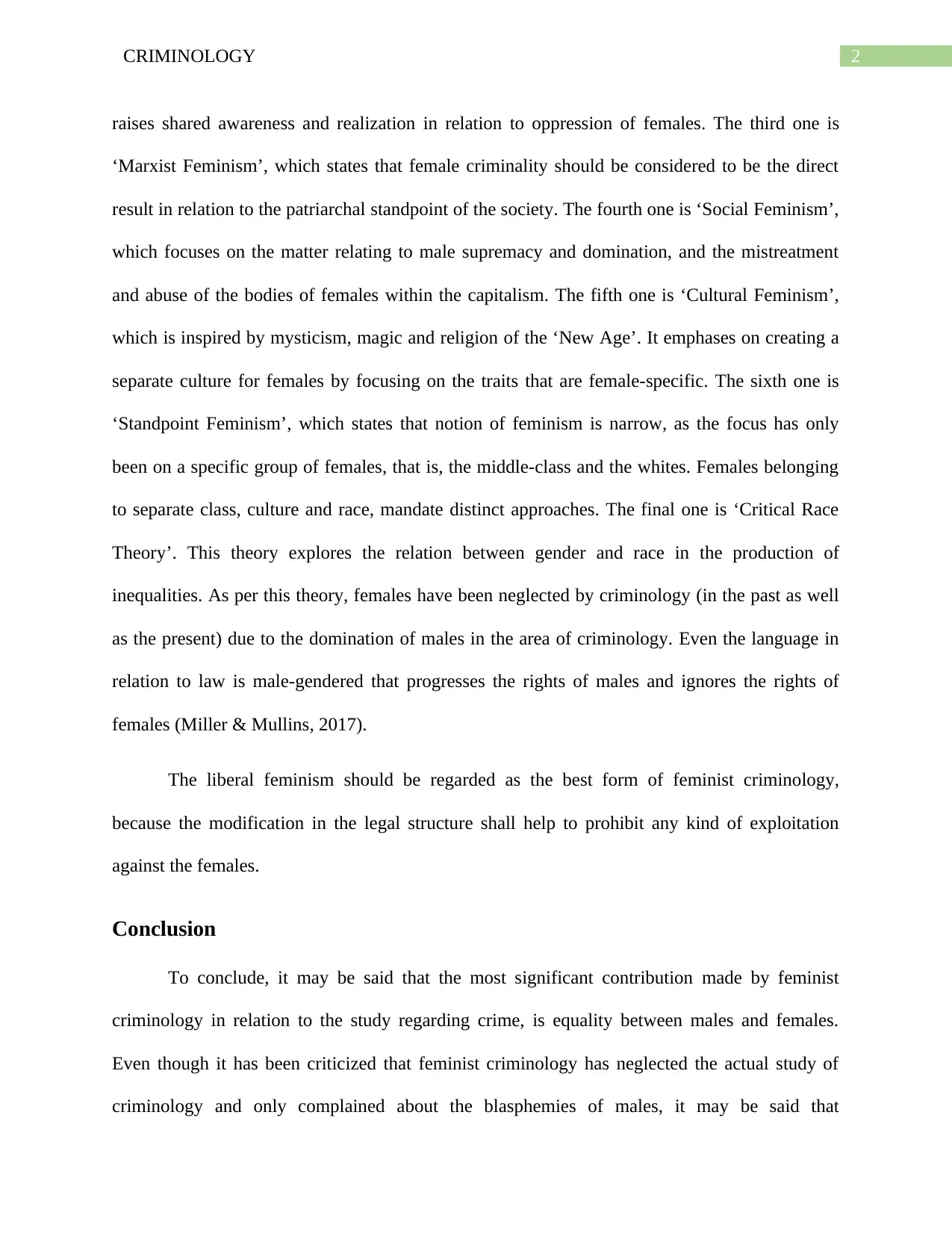
2CRIMINOLOGY
raises shared awareness and realization in relation to oppression of females. The third one is
‘Marxist Feminism’, which states that female criminality should be considered to be the direct
result in relation to the patriarchal standpoint of the society. The fourth one is ‘Social Feminism’,
which focuses on the matter relating to male supremacy and domination, and the mistreatment
and abuse of the bodies of females within the capitalism. The fifth one is ‘Cultural Feminism’,
which is inspired by mysticism, magic and religion of the ‘New Age’. It emphases on creating a
separate culture for females by focusing on the traits that are female-specific. The sixth one is
‘Standpoint Feminism’, which states that notion of feminism is narrow, as the focus has only
been on a specific group of females, that is, the middle-class and the whites. Females belonging
to separate class, culture and race, mandate distinct approaches. The final one is ‘Critical Race
Theory’. This theory explores the relation between gender and race in the production of
inequalities. As per this theory, females have been neglected by criminology (in the past as well
as the present) due to the domination of males in the area of criminology. Even the language in
relation to law is male-gendered that progresses the rights of males and ignores the rights of
females (Miller & Mullins, 2017).
The liberal feminism should be regarded as the best form of feminist criminology,
because the modification in the legal structure shall help to prohibit any kind of exploitation
against the females.
Conclusion
To conclude, it may be said that the most significant contribution made by feminist
criminology in relation to the study regarding crime, is equality between males and females.
Even though it has been criticized that feminist criminology has neglected the actual study of
criminology and only complained about the blasphemies of males, it may be said that
raises shared awareness and realization in relation to oppression of females. The third one is
‘Marxist Feminism’, which states that female criminality should be considered to be the direct
result in relation to the patriarchal standpoint of the society. The fourth one is ‘Social Feminism’,
which focuses on the matter relating to male supremacy and domination, and the mistreatment
and abuse of the bodies of females within the capitalism. The fifth one is ‘Cultural Feminism’,
which is inspired by mysticism, magic and religion of the ‘New Age’. It emphases on creating a
separate culture for females by focusing on the traits that are female-specific. The sixth one is
‘Standpoint Feminism’, which states that notion of feminism is narrow, as the focus has only
been on a specific group of females, that is, the middle-class and the whites. Females belonging
to separate class, culture and race, mandate distinct approaches. The final one is ‘Critical Race
Theory’. This theory explores the relation between gender and race in the production of
inequalities. As per this theory, females have been neglected by criminology (in the past as well
as the present) due to the domination of males in the area of criminology. Even the language in
relation to law is male-gendered that progresses the rights of males and ignores the rights of
females (Miller & Mullins, 2017).
The liberal feminism should be regarded as the best form of feminist criminology,
because the modification in the legal structure shall help to prohibit any kind of exploitation
against the females.
Conclusion
To conclude, it may be said that the most significant contribution made by feminist
criminology in relation to the study regarding crime, is equality between males and females.
Even though it has been criticized that feminist criminology has neglected the actual study of
criminology and only complained about the blasphemies of males, it may be said that
⊘ This is a preview!⊘
Do you want full access?
Subscribe today to unlock all pages.

Trusted by 1+ million students worldwide

3CRIMINOLOGY
nonetheless, feminist criminology has prompted the world to think about a male and a female in
the light of same status.
nonetheless, feminist criminology has prompted the world to think about a male and a female in
the light of same status.
Paraphrase This Document
Need a fresh take? Get an instant paraphrase of this document with our AI Paraphraser
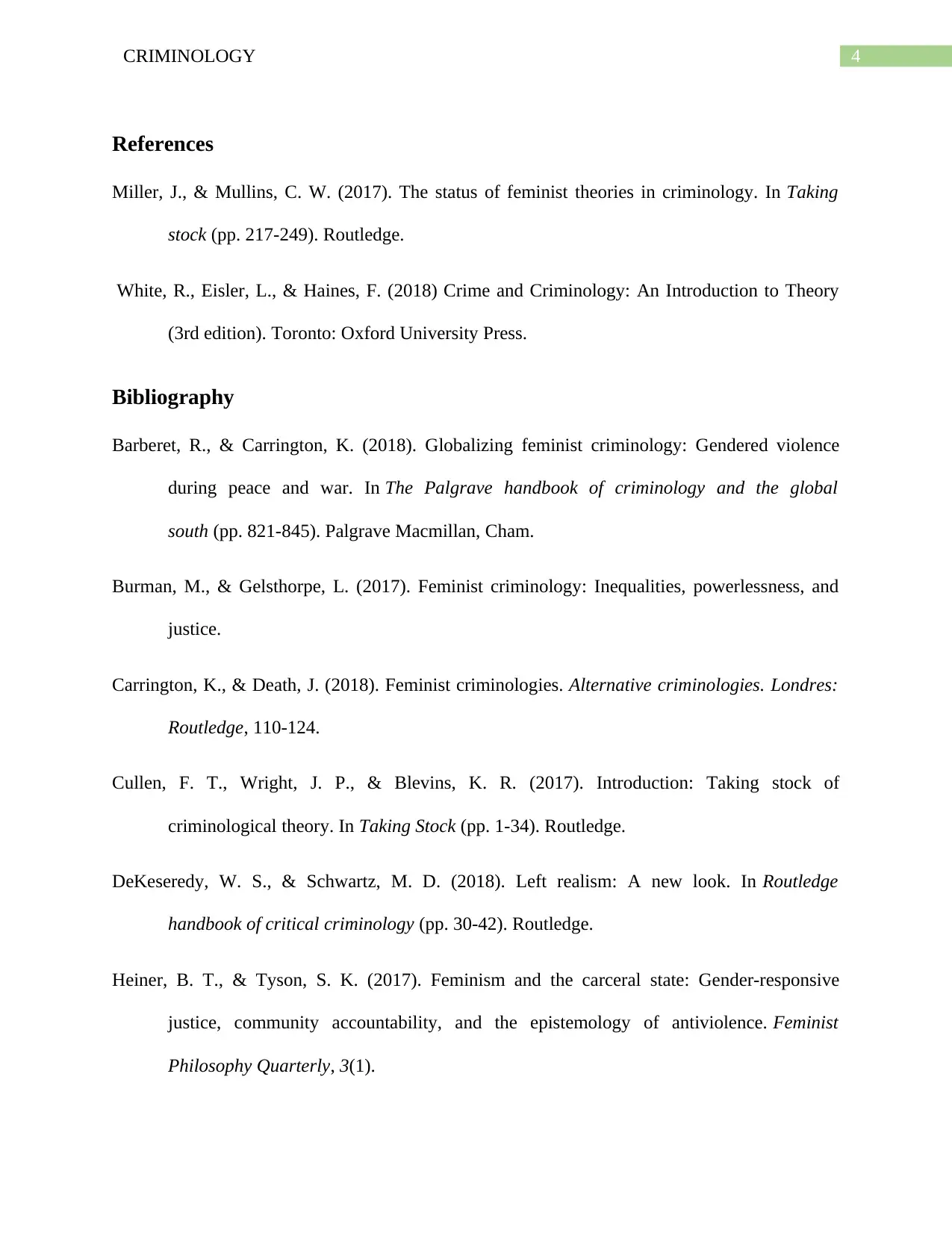
4CRIMINOLOGY
References
Miller, J., & Mullins, C. W. (2017). The status of feminist theories in criminology. In Taking
stock (pp. 217-249). Routledge.
White, R., Eisler, L., & Haines, F. (2018) Crime and Criminology: An Introduction to Theory
(3rd edition). Toronto: Oxford University Press.
Bibliography
Barberet, R., & Carrington, K. (2018). Globalizing feminist criminology: Gendered violence
during peace and war. In The Palgrave handbook of criminology and the global
south (pp. 821-845). Palgrave Macmillan, Cham.
Burman, M., & Gelsthorpe, L. (2017). Feminist criminology: Inequalities, powerlessness, and
justice.
Carrington, K., & Death, J. (2018). Feminist criminologies. Alternative criminologies. Londres:
Routledge, 110-124.
Cullen, F. T., Wright, J. P., & Blevins, K. R. (2017). Introduction: Taking stock of
criminological theory. In Taking Stock (pp. 1-34). Routledge.
DeKeseredy, W. S., & Schwartz, M. D. (2018). Left realism: A new look. In Routledge
handbook of critical criminology (pp. 30-42). Routledge.
Heiner, B. T., & Tyson, S. K. (2017). Feminism and the carceral state: Gender-responsive
justice, community accountability, and the epistemology of antiviolence. Feminist
Philosophy Quarterly, 3(1).
References
Miller, J., & Mullins, C. W. (2017). The status of feminist theories in criminology. In Taking
stock (pp. 217-249). Routledge.
White, R., Eisler, L., & Haines, F. (2018) Crime and Criminology: An Introduction to Theory
(3rd edition). Toronto: Oxford University Press.
Bibliography
Barberet, R., & Carrington, K. (2018). Globalizing feminist criminology: Gendered violence
during peace and war. In The Palgrave handbook of criminology and the global
south (pp. 821-845). Palgrave Macmillan, Cham.
Burman, M., & Gelsthorpe, L. (2017). Feminist criminology: Inequalities, powerlessness, and
justice.
Carrington, K., & Death, J. (2018). Feminist criminologies. Alternative criminologies. Londres:
Routledge, 110-124.
Cullen, F. T., Wright, J. P., & Blevins, K. R. (2017). Introduction: Taking stock of
criminological theory. In Taking Stock (pp. 1-34). Routledge.
DeKeseredy, W. S., & Schwartz, M. D. (2018). Left realism: A new look. In Routledge
handbook of critical criminology (pp. 30-42). Routledge.
Heiner, B. T., & Tyson, S. K. (2017). Feminism and the carceral state: Gender-responsive
justice, community accountability, and the epistemology of antiviolence. Feminist
Philosophy Quarterly, 3(1).
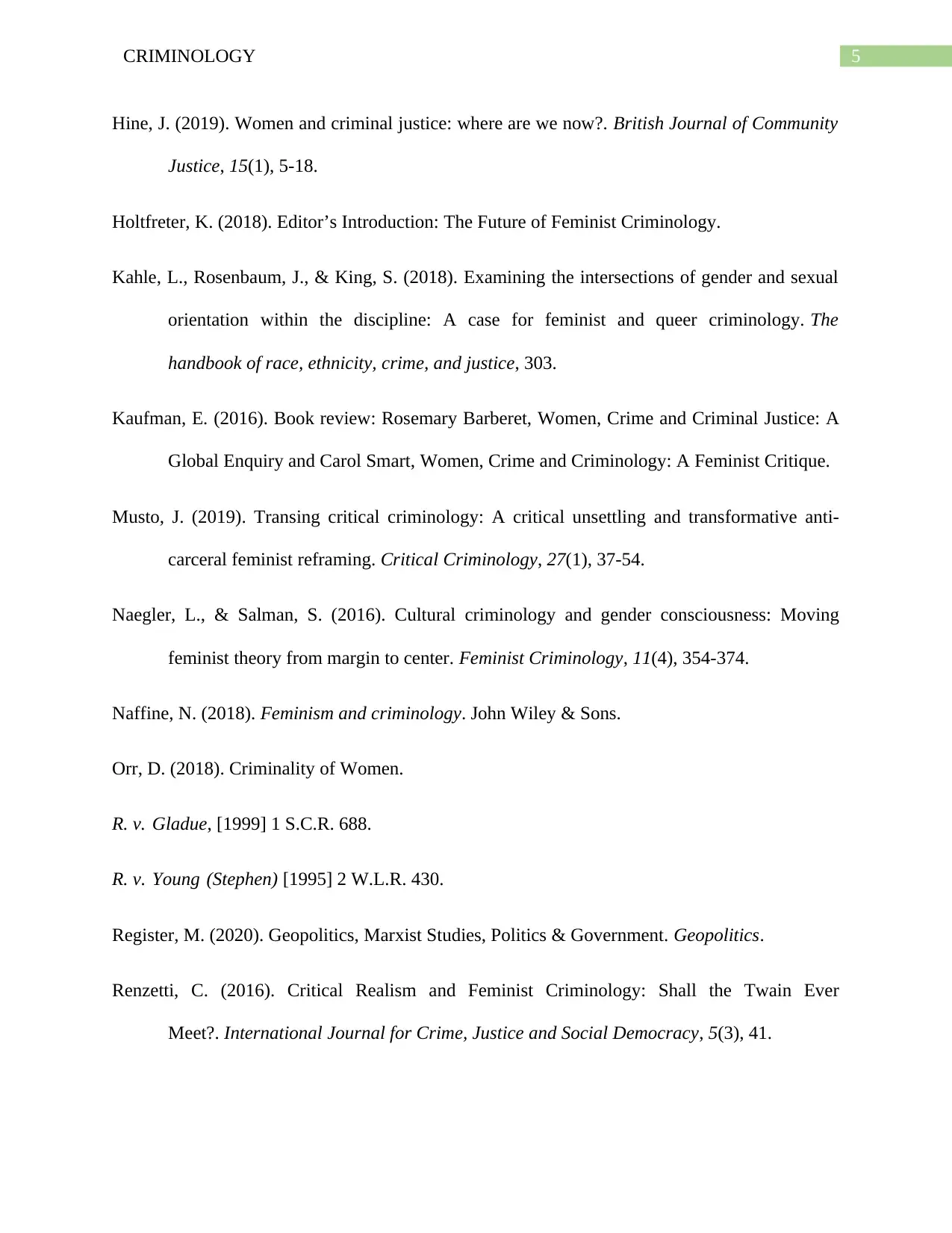
5CRIMINOLOGY
Hine, J. (2019). Women and criminal justice: where are we now?. British Journal of Community
Justice, 15(1), 5-18.
Holtfreter, K. (2018). Editor’s Introduction: The Future of Feminist Criminology.
Kahle, L., Rosenbaum, J., & King, S. (2018). Examining the intersections of gender and sexual
orientation within the discipline: A case for feminist and queer criminology. The
handbook of race, ethnicity, crime, and justice, 303.
Kaufman, E. (2016). Book review: Rosemary Barberet, Women, Crime and Criminal Justice: A
Global Enquiry and Carol Smart, Women, Crime and Criminology: A Feminist Critique.
Musto, J. (2019). Transing critical criminology: A critical unsettling and transformative anti-
carceral feminist reframing. Critical Criminology, 27(1), 37-54.
Naegler, L., & Salman, S. (2016). Cultural criminology and gender consciousness: Moving
feminist theory from margin to center. Feminist Criminology, 11(4), 354-374.
Naffine, N. (2018). Feminism and criminology. John Wiley & Sons.
Orr, D. (2018). Criminality of Women.
R. v. Gladue, [1999] 1 S.C.R. 688.
R. v. Young (Stephen) [1995] 2 W.L.R. 430.
Register, M. (2020). Geopolitics, Marxist Studies, Politics & Government. Geopolitics.
Renzetti, C. (2016). Critical Realism and Feminist Criminology: Shall the Twain Ever
Meet?. International Journal for Crime, Justice and Social Democracy, 5(3), 41.
Hine, J. (2019). Women and criminal justice: where are we now?. British Journal of Community
Justice, 15(1), 5-18.
Holtfreter, K. (2018). Editor’s Introduction: The Future of Feminist Criminology.
Kahle, L., Rosenbaum, J., & King, S. (2018). Examining the intersections of gender and sexual
orientation within the discipline: A case for feminist and queer criminology. The
handbook of race, ethnicity, crime, and justice, 303.
Kaufman, E. (2016). Book review: Rosemary Barberet, Women, Crime and Criminal Justice: A
Global Enquiry and Carol Smart, Women, Crime and Criminology: A Feminist Critique.
Musto, J. (2019). Transing critical criminology: A critical unsettling and transformative anti-
carceral feminist reframing. Critical Criminology, 27(1), 37-54.
Naegler, L., & Salman, S. (2016). Cultural criminology and gender consciousness: Moving
feminist theory from margin to center. Feminist Criminology, 11(4), 354-374.
Naffine, N. (2018). Feminism and criminology. John Wiley & Sons.
Orr, D. (2018). Criminality of Women.
R. v. Gladue, [1999] 1 S.C.R. 688.
R. v. Young (Stephen) [1995] 2 W.L.R. 430.
Register, M. (2020). Geopolitics, Marxist Studies, Politics & Government. Geopolitics.
Renzetti, C. (2016). Critical Realism and Feminist Criminology: Shall the Twain Ever
Meet?. International Journal for Crime, Justice and Social Democracy, 5(3), 41.
⊘ This is a preview!⊘
Do you want full access?
Subscribe today to unlock all pages.

Trusted by 1+ million students worldwide
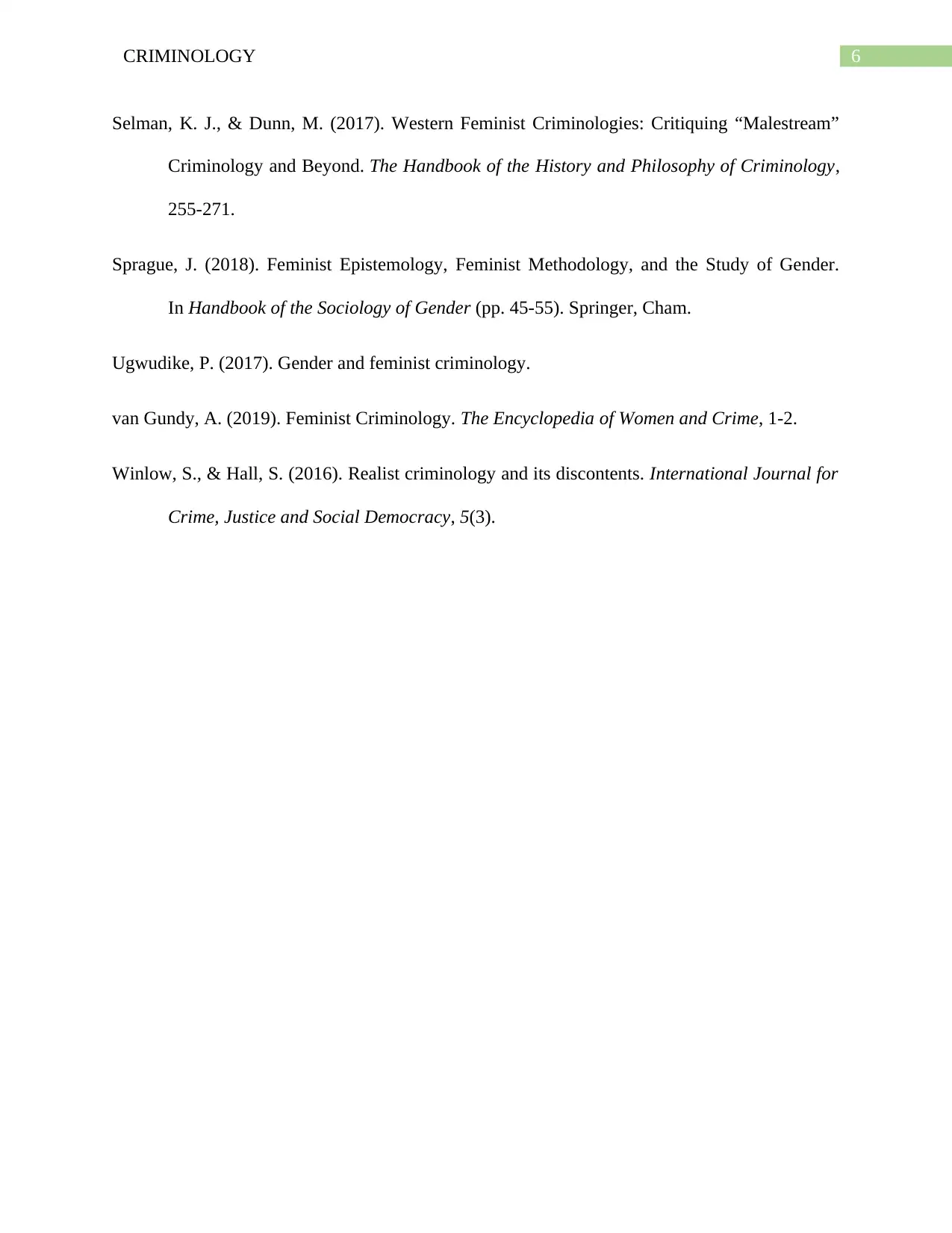
6CRIMINOLOGY
Selman, K. J., & Dunn, M. (2017). Western Feminist Criminologies: Critiquing “Malestream”
Criminology and Beyond. The Handbook of the History and Philosophy of Criminology,
255-271.
Sprague, J. (2018). Feminist Epistemology, Feminist Methodology, and the Study of Gender.
In Handbook of the Sociology of Gender (pp. 45-55). Springer, Cham.
Ugwudike, P. (2017). Gender and feminist criminology.
van Gundy, A. (2019). Feminist Criminology. The Encyclopedia of Women and Crime, 1-2.
Winlow, S., & Hall, S. (2016). Realist criminology and its discontents. International Journal for
Crime, Justice and Social Democracy, 5(3).
Selman, K. J., & Dunn, M. (2017). Western Feminist Criminologies: Critiquing “Malestream”
Criminology and Beyond. The Handbook of the History and Philosophy of Criminology,
255-271.
Sprague, J. (2018). Feminist Epistemology, Feminist Methodology, and the Study of Gender.
In Handbook of the Sociology of Gender (pp. 45-55). Springer, Cham.
Ugwudike, P. (2017). Gender and feminist criminology.
van Gundy, A. (2019). Feminist Criminology. The Encyclopedia of Women and Crime, 1-2.
Winlow, S., & Hall, S. (2016). Realist criminology and its discontents. International Journal for
Crime, Justice and Social Democracy, 5(3).
1 out of 7
Related Documents
Your All-in-One AI-Powered Toolkit for Academic Success.
+13062052269
info@desklib.com
Available 24*7 on WhatsApp / Email
![[object Object]](/_next/static/media/star-bottom.7253800d.svg)
Unlock your academic potential
Copyright © 2020–2025 A2Z Services. All Rights Reserved. Developed and managed by ZUCOL.





